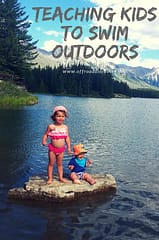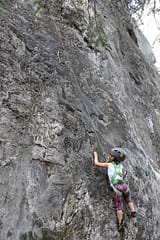Teaching Kids to Swim in Lakes
Tips on teaching your kids to swim while having fun outside
Contents
Introduction
So you keep to going to lakes with your kids but they don’t know how to swim. How do you get them started? Here’s a step by step guide on how to introduce young children to swimming in lakes. Both of us were swim instructors, we believe swimming is an important skill for everyone and a fun way to spend time out doors.
These Kids Love Mountain Lakes and Only Know Cold Water
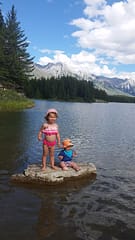
Two Key Steps in Teaching Kids to Swim Outdoors
Step 1: Touch the water
When you first get to a lake or ocean the hardest part about getting in is overcoming the temperature change. Where we live depending on the season the water temperature can be anywhere from cool to heart attack. Touching the water and slowly wading your body in through a few in and out cycles where you slowly go deeper and deeper can help acclimatize your body. This holds true for children too, who at first will be content to let the small waves at shore nibble at their toes while they squeal like little piglets. The natural evolution of this behavior will be to explore the shallow areas as their lower extremities become use to the cool water.
Playing by the Water, First Step to a Little Swimmer
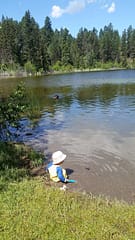
Step 2: Use a PFD (Personnel Flotation Devices)
PFDs are fundamental part of teaching children how to swim for two reasons:
- To mitigate any risk of incident while a child is entering or around water.
- Building the confidence of a child as they enter into the water to deeper and deeper depths and less and less holding from an adult.
There are many types of PFDs and in our opinion life-jackets are not necessarily the best type of device for starting a child on a path of learning to swim (unless it is off a boat). The reason for this is that life-jackets have been designed for boating incidents to keep airways open and flip individuals on their backs in case that individual happens to be unconscious. It has been our experience that flotation devices with foam around the rib cage and around the upper arms similar to water wings provides the best platform to develop a child’s special awareness in a front float position.
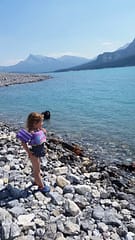
1 – 2 year old
Swimming during this part of life will inevitably require a parent or guardian to hold the child as they enter the water. Gradually as the child and guardian acclimatize to the water the ultimate goal is to get both individuals submerged to your neck and if possible floating (child in flotation device). The speed in which you can accomplish this will largely depend on the guardians comfort level in the water. Most important aspect is to make sure the child has fun and does not develop a fear of the water. There is however a fine line between true fear and hesitation of the initial uncertainty of being in a large body of water that can quickly turn into joy once the feeling of full flotation has been achieved. Take it slowly and keep a keen eye on signs of the child getting cold, blue lips and shivering. There is nothing like a warm towel and snacks after a lake swim to reward everyone’s efforts.
Warming Up and Snacking

2 - 4 year old
As children become more comfortable with their water wing based PFD you will see remarkable improvement in their ability to propel themselves through the water. As this skill level increases so will the distance this child feels comfortable being away from their parent or guardian. It’s important that this phase to not become compliant with the skill level of your child’s swimming ability. A wave or misplaced breath can leave a child gasping for air that may require quick assistance. It is during this period that focusing on the basics of swimming are important; blowing bubbles is paramount. Once comfortable putting chins and noses in water next step is whole head on their own. Kicking with straight legs can often be demonstrated when using your arms ensuring to explain that the best way to move is keeping your legs under the water. Back floats are always a challenge but generally some persistent help in the beginning and the explanation to put your belly button in the air and arms and legs out like a start will eventually get the job done. If you can find a dock you can get a lot of development from learning how to jump into the water. If you can get these few techniques polished up in a lake or pool you’ve essentially completed the first and most of the second level of typical swimming classes. The next steps are removing the PFD.
Once They Are in They Don’t Want Out, Except for Snacks
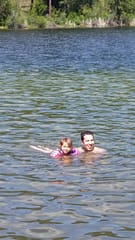
Learning to Swim Comes with a lot of Play Time
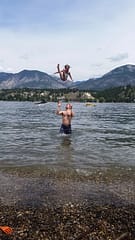
Enjoy lake time as a family, it’s one of our favorite pass-times.
